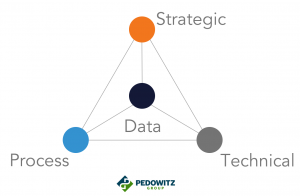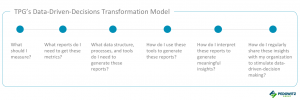“However beautiful the strategy, you should occasionally look at the results,”– Winston Churchill
 Never has the need for data-driven decisions been more critical to optimizing marketing performance than they are today. Digital transformations have created more and richer data about our customers and prospects. Marketing teams that are serious about contributing to the business are serious about turning that data into customer insights. Generating more urgency is the rise in business accountability.
Never has the need for data-driven decisions been more critical to optimizing marketing performance than they are today. Digital transformations have created more and richer data about our customers and prospects. Marketing teams that are serious about contributing to the business are serious about turning that data into customer insights. Generating more urgency is the rise in business accountability.
Gartner reports in their 2017 CMO Spend Survey that 76% of marketing organizations at least share accountability for a P&L. Yet, Aberdeen finds that only 19% of marketers have comprehensive tracking and reporting practices in place. This leads me to conclude that most marketers are managing by gut feel, a wholly insufficient practice in today’s data-rich environment.
Also Read: The Right Time for the Millennial Marketer
The Four Fundamental Elements of Data-Driven-Decisions
Transforming into a data-driven organization requires four fundamental elements are in place. Without any one of these, you limit the insights available to your organization and cast doubt on the validity of the insights that are available. Address all four competently and you’ll create the environment to produce robust insights.
The four fundamental elements are– Strategy, Process, Technology, and Data.

Strategy: This is your organization’s plan for how you’ll transform and specifically how you’ll use data to generate meaningful insights.
Technical: Putting the right tools and systems in place to capture, store, measure, and analyze data and then share the resulting insights to your organization.
Process: Ensuring all your processes enrich rather than pollute your data set.
Data: Making sure you have the right data architecture, quality and completeness to generate the insights your organization needs to move the business forward.
As you can understand, lacking any of the four fundamental elements will leave your organization wanting. Without the right data, you won’t generate any insights or the ones you do will be called into question. The lack of processes, or inconsistent processes, will corrupt your data set.
Without the proper technology (and no, this isn’t a green light to get a BI tool) you simply won’t be able to generate or share the insights you need. And without a strategy tailored to your organization, you won’t know what tools, processes, and data you need because you won’t know which insights are critical to maintaining your business health.
Also Read: How Marketing Ops Runs Marketing Like a Business
A Methodology for Putting this into Practice
Start the Transformation
After years of consulting on decision-making, I’ve uncovered six critical, largely sequential, questions all organizations must effectively answer if they’re to move to data-driven-decision making. These questions appear whether you’re just starting out in your measurement maturity or you’re well on your way to advanced measurement.
These questions are–
- What should I measure?
- What reports do I need to get these metrics?
- What data structure, processes, and tools do I need to generate these reports?
- How do I use these tools to generate these reports?
- How do I interpret these reports to generate meaningful insights?
- How do I regularly share these insights with my organization to stimulate data-driven-decision making?

As you can see, these questions address the four fundamental elements directly and also address the insight generation and institutionalization elements that move your organization to data-driven marketers in practice.
As you’ll also notice, selecting what you’re going to measure (strategy) is the first step for a reason. It guides answers to all the other questions. This step is so critical that I recently conducted a half-day workshop on it at B2B Marketing Exchange for a packed room.
In answering this question, you must develop a KPI Roadmap to set the strategic direction for your team. Let’s explore why this is so critical.
Also Read: How Marketing Operations Affects Marketing Accountability
The Criticality of a KPI Roadmap
Here, we’re going a bit meta, as we’re addressing the strategy for determining which results to pay attention to. Marketing is a science and an art, with the science side of the equation getting a lot of focus lately, especially in the area of marketing ops. The primary implication is that marketers will act like scientists: they will experiment, collect results, analyze those results and then make decisions based on the insights. These data-driven-decisions, or 3D, are the hallmark of a science-based marketing team.
Choosing KPIs Is a Fundamental Function of Leadership
As marketing leaders, our purpose is to maximize the potential of our teams. The selection of Key Performance & Predictive Indicators (KPIs) directly impacts our fulfillment of that purpose. Done correctly, the right KPIs foster harmony and collaboration. They empower our teams and focus their effort where they have a meaningful impact. A misstep here, though, and the wrong KPIs create dissonance and drain creativity out of our teams.
A KPI roadmap is the strategic plan of specific KPIs your team should adopt for data-driven-decision making. These KPIs are phased over time to capitalize on advancing maturity and to ensure the team is able to consume and use the KPIs you’re measuring. Too much data can be as, if not more, detrimental than too little data.
A KPI roadmap is the framework for defining process and data structures that support the KPIs and ultimately generate reliable insights. You can’t lean on the data if you don’t trust your data. This roadmap guides analysts in their report selection. It also informs the timeline for when a BI tool will be necessary, avoiding the premature purchase of a shiny new system.
Also Read: Fireside Chat with Jeff Pedowitz
Keep It Inquisitive
At the workshop, it was clear that KPI adoption is still a sensitive issue. Across multiple organizations, participants told me stories of resistance to measurement and a fear of the transparency good KPI measurement and reporting enables. This fear is very real and unfortunately, in some organizations, very justified.
If the leadership doesn’t engender a culture of experimentation and inquisitiveness and instead uses this new transparency for data-driven persecution, you will fail to establish a data-driven culture. The team will resist and sabotage the effort at every turn.
An effort that could have been directed to generating and acting on insights will be wasted on defense and disruption (not the market-defining kind). It’s imperative as a leader to instill confidence in your team that this new transparency will be used to uncover insights that will improve the performance of individuals and the organization as a whole. There is a world of difference between a failure and a mistake. Failure is the natural result of experimentation while failures can be controlled and minimized.
You must address the human needs of your people if you’re going to implement a data-driven culture, which accepts the results of many experiments as key learnings that should be captured and shared, improving the results of the entire team.
Also Read: Core Organizational Ingredients of the Ever-Expanding Marketing Operations Function







Comments are closed.